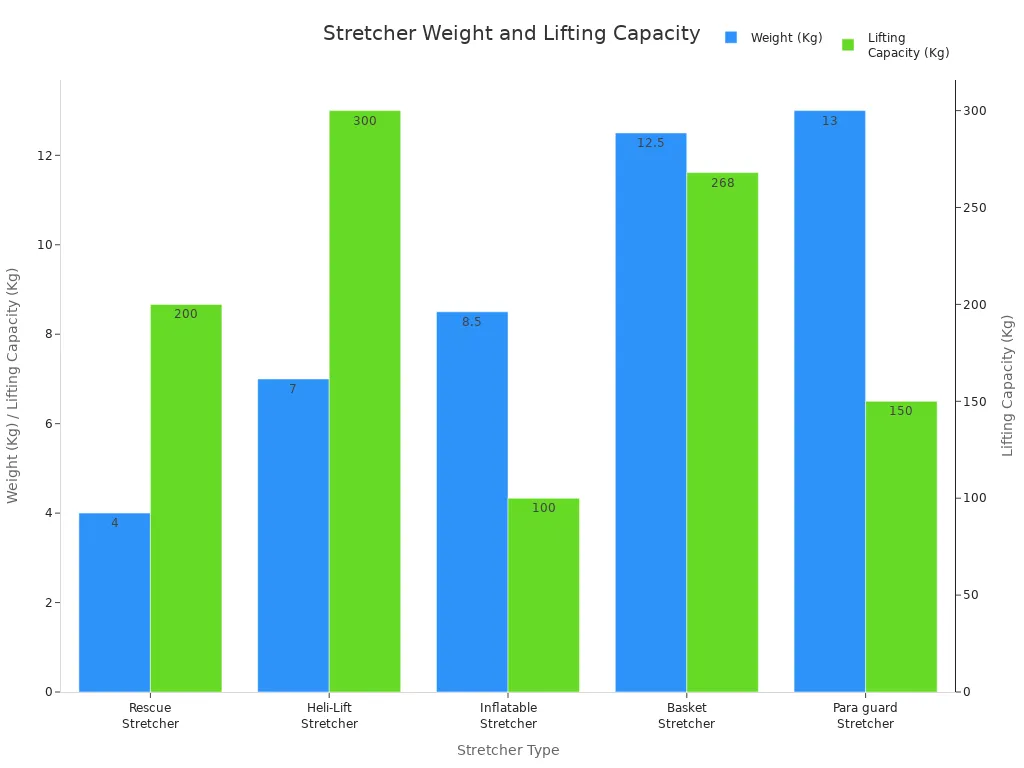Views: 0 Author: Site Editor Publish Time: 2025-09-09 Origin: Site








You may hear the ambulance stretcher called other names, like:
gurney
patient cot
medical stretcher
transport stretcher
rescue stretcher
People use an ambulance stretcher to move patients fast and safely in emergencies. It has a strong frame and a soft top. These parts help keep patients comfortable and safe while they are moved.
Ambulance stretchers are also called gurneys or medical stretchers. They help move patients safely in emergencies.
Modern stretchers use light materials and have safety straps. Their design makes patients feel safe and comfortable.
You should check the stretcher's straps and brakes before moving anyone. This keeps patients safe and stops accidents.
You will see an ambulance stretcher in most emergency vehicles. People sometimes call it a gurney or a cot. Ambulance stretchers help move patients who need medical care. The stretcher has a strong frame and a soft top. Most stretchers have handles and wheels. These parts help you move patients fast and keep them safe.
Modern ambulance stretchers have many helpful features. These features make your work easier and help patients feel better. Check the table below for some important features:
Feature | Description |
|---|---|
Lightweight and Durable Materials | Aluminum alloys and strong plastics make the stretcher light and strong for emergencies. |
Hydraulic and Electric Assist | You can lift or lower the stretcher with less work, so you stay safe and work faster. |
Enhanced Safety Features | Wheels that lock and straps that adjust keep the stretcher steady and the patient safe. |
Ergonomic Designs | Soft padding and backrests that move help patients feel good during the ride. |
Infection Control Features | Surfaces are easy to clean and have coatings that stop germs from spreading. |
Modular and Customizable Options | You can add extra parts to help different patients. |
Power Loading Systems | Machines can load and unload the stretcher, so you do not get hurt. |
Integrated Technology | Some stretchers have screens that check vital signs and send info to hospitals. |
Compact and Foldable Designs | You can fold and store the stretcher in small spaces. |
The materials used in stretchers are important. Most ambulance stretchers use aluminum, stainless steel, PVC, or nylon with a special coating. These materials last a long time and can handle rough use. They are easy to clean, which helps stop germs.
“The biggest thing for us,” said Reed, “is that the [Safety Arm] lets us secure our cardiac monitor so it’s crash-rated but still usable.” This matters because loose equipment can hurt people in a crash.
You must always think about safety when using ambulance stretchers. The design helps keep patients safe in many ways:
Use all the safety straps to stop falls.
Change the stretcher height to load and unload easily.
Lock the brakes when you stop so the stretcher does not move.
Use powered lifts to help with heavy patients and protect your back.
Check the straps, especially on bumpy ground.
Look at the stretcher often and fix anything broken right away.
Watch the patient’s health during the ride.
Ergonomic designs help you move patients without hurting yourself. Battery-powered lifts mean you do not have to lift heavy things. You can use IV poles and oxygen holders while moving the patient. These features make ambulance stretchers safer for everyone.
You use an ambulance stretcher to move patients fast. It helps you keep patients safe during emergencies. The medical transport stretcher fits inside ambulances. It works with other EMS tools. You can change the stretcher to help the patient feel better. It keeps the patient steady while riding.
When you get to the scene, you follow steps to keep the patient safe:
Use the stretcher right so the patient feels okay.
Lift the head of the stretcher if needed.
Hold the handles and ask for help to lift.
Add the IV pole if the patient needs medicine.
Ambulance stretchers help you move patients from accidents, homes, or hospitals. You can load and unload patients fast. This is important for quick transport. The medical transport stretcher keeps the patient safe and stops too much movement. It helps the patient stay comfortable and safe every time.
�� Tip: Always check the straps and brakes before you move the stretcher. This keeps it steady and safe.
In emergencies, you must act quickly. The medical transport stretcher lets you help people fast. You can put patients on the stretcher in seconds. This saves time. The stretcher’s design helps you move patients over rough ground and stairs.
Here are some benefits of using a medical transport stretcher:
Benefit Category | Description |
|---|---|
Safe Patient Transport | Lowers injury risk and keeps the patient safe. |
Improved Patient Comfort | Soft beds and moving backs help patients feel better. |
Efficient Emergency Response | Fast loading and unloading saves time. |
Reduces Rescuer Fatigue | Lifting tools help paramedics and lower injury risk. |
Versatility Across Environments | Works in many places and on different ground. |
Enhanced Patient Safety | Safety belts and supports stop falls and injuries. |
Adaptability for Various Patients | Different stretchers help kids and trauma patients. |
Compatibility with Ambulance Systems | Easy to load and store in ambulances. |
Durability and Hygiene | Strong materials last long and stay clean. |
Supports Medical Procedures En Route | Lets you use IV poles and monitors during transport. |
During big emergencies, you need to move patients fast. Some stretchers, like flexible tarps or inflated stretchers, help you do this. The fastest time to move a patient was under 10 seconds with special gear. Stretchers that are quick and steady work best.
Some stretchers help you move patients fast in big emergencies.
Flexible tarps are quick and keep patients steady.
Inflated stretchers and tarps are very stable and safe.
You can use the medical transport stretcher as a mobile care spot. It lets you check the patient and give care while moving. Some stretchers have tech to check vital signs and send info to the hospital.
You see ambulance stretchers in many places besides emergencies. In the military, you use special stretchers for high rescues or helicopter lifts. Search and rescue teams use stretchers in snow, water, or rough ground. Some stretchers fold or inflate, so you can carry them on long trips or mountain rescues.
Stretcher Type | Dimensions (cm) | Weight (Kg) | Lifting Capacity (Kg) | Unique Features |
|---|---|---|---|---|
Rescue Stretcher | 220 × 85 | 4 | 200 | Holds patient for high rescues. |
Heli-Lift Stretcher | 220 × 85 | 6-8 | 300 | Safe for helicopter lifts; has a warm blanket. |
Inflatable Stretcher | 183 × 92 | 8.5 | 100 | Folds up, inflates, safe for spine injuries, light to carry. |
Basket Stretcher | 216 × 61 × 18 | 12.5 | 268 | Works on snow and water; can be lifted up. |
Spine Board | N/A | N/A | N/A | Used for patients with spine injuries. |
Para guard Stretcher | 183 × 33 | 13 | 150 | Fully covers patient; good for lifts; used in helicopters. |

In disasters, you use the ambulance stretcher to get patients out of danger. It helps you keep them safe while moving. The stretcher gives you a steady place for first aid. You can check the patient while moving. You can change the stretcher for comfort and use IV poles or oxygen holders.
Move patients fast from dangerous places
Steady spot for quick checks and care
Straps and supports keep patients safe
Give care and watch patients while moving
Reach patients in hard places
Load into ambulances quickly and safely
Move patients smoothly to hospital teams
Some stretchers have smart features now. You can check vital signs and send updates to the hospital. This helps the medical team get ready before you arrive. The new tech helps patients and supports emergency teams in every case.
In emergency medical care, you see many stretchers. Each type helps you move patients fast and safe. Knowing the types helps you pick the right one.
Standard ambulance stretchers are in almost every ambulance. These stretchers have wheels and a strong frame. You can change the height to help load and unload. Most hold up to 450 pounds. Some can carry even more weight. Safety straps and locking wheels keep patients safe.
Specification | Details |
|---|---|
Typical Weight Capacity | Up to 450 pounds |
Additional Capacity | Options available for higher weights |
Standard ambulance stretchers fit most patients. You can adjust the height and use straps for safety. These stretchers work well for emergencies and hospital trips.
Tip: Always check straps and brakes before moving a patient. This helps stop accidents.
Specialized stretchers help in special cases. These stretchers are for patients with special needs or tough places. Here are some common types you might use:
Wheeled stretchers: Good for most ambulance rides.
Basket stretchers: Strong and safe for rough ground.
Spine boards: Help move patients with spine injuries.
Stair chairs: Move patients down stairs or in tight spots.
Portable or folding stretchers: Easy to carry and store.
Scoop stretchers: Lift patients with little movement.
Type of Stretcher | Intended Use |
|---|---|
Scoop Stretcher | Helps stop spine injury when moving. |
Basket Stretcher | Good for air or sea rescue and rough ground. |
Stair Chair | Moves patients safely over stairs and in small spaces. |
Spine Board | Keeps the body straight for spine or limb injuries. |
When you choose a stretcher, think about your patient’s needs. Also think about where you are and your safety. Specialized stretchers help patients in hard rescues or with spine injuries. You can see how each stretcher helps in emergency care.
Ambulance stretchers help you move patients fast and safe. The design makes your job easier in many ways. You do not have to lift as much weight. You can move the stretcher easily and change its height. Patients have a steady and soft place to rest.

You give better care when you use all the safety straps. Always check the brakes before moving the stretcher. Make sure the equipment works well every time. Good stretchers keep you and your patients safe in emergencies.
Ambulance stretchers help you move patients fast and safe. They let you act quickly when someone needs help. They also make sure patients get good care.
You use safety straps to hold the patient in place. You lock the wheels so the stretcher does not roll. You check everything before you move the stretcher. These steps keep the patient safe and help you give good care.
Yes, you can use them in hospitals or during rescues. You can also use them in places where disasters happen. Ambulance stretchers help you move patients safely anywhere you need.


